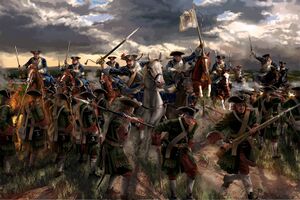Battle of Jefford's Junction
| Battle of Jefford's Junction | |||||||
|---|---|---|---|---|---|---|---|
| Part of the Aquitaynian War of Independence | |||||||
 Imperial Guard cavalry slam into Aswickian lines | |||||||
| |||||||
| Belligerents | |||||||
|
|
| ||||||
| Commanders and leaders | |||||||
| Col. Joseph Mercer | Castus Tamphilus | ||||||
| Strength | |||||||
| 1,550 | 1,300 | ||||||
| Casualties and losses | |||||||
|
611 115 captured Total: 1147 |
551 wounded 14 missing Total:901 | ||||||
The Battle of Jefford's Junction was fought on October 3, 1741, between forces of the Empire of Exponent's Imperial Guard Corp and the Royal Aswickan Army. The Imperial forces were successful in clearing the Aswickans from the field, but the battle severely mauled the Imperial Guards, causing them to withdraw from combat for the remainder of the campaign.
Background
Battle
Forming of the lines and initial advance
Colonel Joseph Mercer, commanding the Aswickan forces defending the road junction, deliberately chose for a defensive strategy. The terrain was advantageous to his forces, and gave clear sight to the battery of 4 12-pounder guns he had available to him.
Imperial forces initially formed up in a line opposing the Aswickan troops just out of range of the Aswickan artillery. As the began advancing, however, the cannons quickly began firing at the Imperial formation. At some point, quite quickly on, a stray shot flew through the General's group and barely missed Legate Tamphilus, killing two members of his staff and wounding another.
Having closed the distance between the two lines by half, Imperial forces then began taking fire from Aswickan irregular forces: Riflemen and skirmishers had positioned themselves in a slight ditch between the two formations. Though they could not do much, they did harass the Imperials with the rifles, which had a higher range than the Imperials' muskets. The irregulars specifically targeted Imperial officers and non-commissioned officers in an effort to cause disarray in their ranks while performing a fighting retreat to stay out of the ever advancing Imperials.